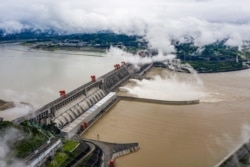Chinese authorities issued more flood warnings Friday as weeks of torrential rains have caused the worst flooding in more than 30 years, destroying the homes and impacting the livelihoods of millions of people, with experts warning the worst is yet to come.
According to the Ministry of Emergency Management, floods have left 141 people dead or missing, destroyed at least 28,000 homes, affected at least 38 million people and caused around $8.6 billion in economic losses. Heavy rains are expected again in provinces in the southern part of the country in the coming week.
Observers have pointed out that President Xi Jinping hasn’t visited any province along the Yangtze River affected by the floods.
As many as 33 rivers have reached record highs, while alerts have been issued for a total of 433 rivers, according to a release by China’s Ministry of Water Resources on July 13. Poyang Lake, formed from the overspill of the Yangtze River, is 2.5 meters higher than its warning level.
The central city of Wuhan, located on the banks of the Yangtze River where COVID-19 emerged late last year, declared red alerts as heavy rain swelled rivers and lakes.
“Our roof is leaking because of the heavy rain. You can see water leaking from the electrical switch box,” Wuhan resident Zhang Yi told VOA.
He added that there’s no electricity in his whole building, and the local government is warning residents to take precautions as water levels fast approach the highest levels that are considered safe.
The worst-hit provinces of Anhui, Jiangxi and Zhejiang also declared red alerts.
Sun Liang, a farmer from Jiangxi province, said that all his crops were immersed in water. Qiu Ting, also from Jiangxi, said that the first floors of most townhouses in her county were under water.
Xi on Friday said governments at all levels should be “mobilized” in fighting the floods and provide relief to those affected.
“It's very important to handle flood prevention and disaster relief work properly, as China will build a moderately prosperous society in all respects and win the battle against poverty by the end of this year,” said Xi during a meeting of the Standing Committee of the Political Bureau of the CPC Central Committee.
Yet locals are telling a different story.
“The local officials are telling us to go live with our families and friends,” Wuhan resident Zhang Yi said, “You see, at the beginning of the year, we weren’t allowed to visit families. Now, we are asked to do so.” He added that he hadn’t received any relief funds or resources from the government so far.
Xi’s absence from areas hard hit by the flooding hasn’t gone unnoticed.
Xia Ming, a professor of political science at the City University of New York, told VOA that almost all former leaders of the Chinese Communist Party personally visited affected areas when the country was hit by natural disasters. “That’s a tradition,” he said. “I think it shows that Xi is scrambling to deal with the coronavirus pandemic, Hong Kong and the worsening U.S.-China relations.”
The authorities also sounded alarms for the Three Gorges reservoir, where the water is now more than 10 meters higher than the warning level.
The Three Gorges Dam, on the Yangtze River in the central region, is the world’s largest hydropower project and also one of the most controversial. Supporters of the project argue that by providing flood storage space, the dam reduces the potential for floods downstream.
Yet critics of the project have said the historically high water levels on the Yangtze River prove the project is failing at what it was designed to do.
“One of the major justifications for the Three Gorges Dam was flood control, but less than 20 years after its completion we have the highest floodwater in recorded history,” David Shankman, a geographer with the University of Alabama who studies Chinese floods, told Reuters. “The fact is that it cannot prevent these severe events.”
Zhang Yi said that most residents don’t understand how the dam works. “We thought it’s just for generating electricity,” he told VOA.
Chinese geologist Fan Xiao has persistently voiced criticism of the dam. He said these major dam projects actually can make flooding worse by altering the flow of sedimentation down the river.
In an interview with Reuters, he said these projects can only partially and temporarily intercept the upstream floods, but are powerless to help with floods caused by heavy rainfall in the middle and lower reaches of the Yangtze River.
Chinese state media CCTV dismissed these concerns as being "hyped by some Western media," saying the Three Gorges Dam “effectively relieved the pressure of flood control on the middle and lower reaches of the river.”









